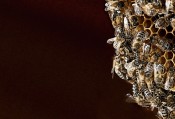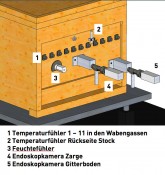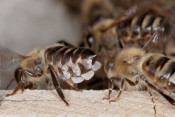|
environment
 >
Learning from honeybees: live observation in the beehive
>
Learning from honeybees: live observation in the beehive
Learning from honeybees: live observation in the beehiveLight in the DarknessInside a beehive it is warm – and utterly dark. The hive members function like a highly complex organism. Some 50,000 individuals live cheek-by-jowl and yet still have room to move. Thanks to the ingenious division of labour, it’s more a case of "busy as a hive" than "busy as a bee". Usually, what occurs in a beehive remains hidden from human view. Not so with HOBOS (HOneyBee Online Studies), the online research platform launched by our team. Specialised cameras operating at specific wavelengths of light enable us to look deep into the hive interior – without any risk that we might disturb the honeybees. Anyone can now view the natural behaviour of the bees in real time. It’s September 10th, 11:06 AM. The air temperature is 24.6°C in the garden where the Würzburg Bee Station is sited and solar radiation is 668.10 watts/m2. Precipitation is zero. Returning home, a forager bee lands on the hive’s bottom board. The camera at the hive entrance films her while – simultaneously – a thermal imaging camera renders the bee’s invisible thermal emissions visible to the human eye: the honeybee is shown in white, as the brightest and warmest area of the thermogram. She has flown from flower to flower, where she has sucked up energy in the form of sweet nectar into her honey sac, which she now wants to deliver within her hive. As she passes through the bidirectional photoelectric barrier and enters the hive she is counted automatically. She is one of 32 bees who enter the hive every minute. She has handled many different tasks in the hive before becoming a forager. In her first three days of life, for example, she worked on tasks in the central brood chamber. She was filmed here earlier, in fact – by the two endoscopic cameras that record events deep in the hive both day and night. Long-term knowledge creation With HOBOS, the honeybees are the stars, since they play a key role in the natural ecosystem and are an irreplaceable factor in terms of human food production. Following cattle and swine as our third most important domesticated animal, honeybees and their pollination underpin a quarter of plant-derived foodstuffs worldwide and yet are now under threat: disease, the introduction of insect pests such as the Varroa mite and habitat loss has made life very difficult for the honeybee. The HOBOS platform enables research scientists to perform observations on a real-life working honeybee colony. Live images and readings taken from the hive and its surroundings can be accessed and correlated with one another. Time frames can be chosen as required. The diagrams that result make the highly-complex life and times of the honeybee – and its natural context – plainly visible. Accordingly, the project is making a contribution to cumulative honeybee research. This knowledge is needed today, since the future of our planet depends on the sound, sustainable handling of the biosphere by humankind. For these reasons, our bee research group has hooked up a real-life honeybee colony to the Internet. The platform has been in existence in preliminary form since 2009 and gives school pupils, teachers, students and beekeepers all over the world a completely new angle on the honeybee’s world. High-tech in the beehive An array of cameras and sensors permit the highly-detailed study of a living bee colony and its environment. HOBOS provides live video streams via a camera at the hive entrance with infrared capabilities, a thermal imaging camera, two endoscope cameras with microphones that film the hive box and bottom board (fig.1) and an infrared-capable camera that logs environmental and weather conditions in the garden.
Fig. 1 The two endoscope cameras that offer views of the colony interior are attached to the back of the beehive.
Data streams – both real-time and historical – are also offered on the bee colony, vegetation and weather conditions. Parameters relating to the hive weight, relative humidity and temperature, temperatures in the eleven gaps between the frames (fig. 2), the temperature at the front and back of the hive, and incoming and outgoing honeybees can also be reviewed. Supplementing the hive data are readings taken from the hive’s immediate vicinity. These include air pressure, temperature and humidity, the atmospheric electric field strength, precipitation, wind speed and direction, solar radiation, soil moisture and leaf wetness (fig. 3).
Fig. 2 The opened beehive, showing temperature sensors 1–11 in the frame gaps.
Fig. 3 The environmental sensor array in the bee project garden consists of weather instrumentation and a flash detector for the atmospheric electric field. The weather instrumentation measures soil moisture, air pressure, temperature, air humidity, solar radiation, precipitation, leaf wetness and wind parameters. Data is recorded using a data logger. The system is equipped with an autonomous power supply.
A new way to learn Honeybees are appealing, highly motivational and quick to arouse interest. They offer an extremely rich biology, from simple facts to highly-complex phenomena. Today and in the future, the independent acquisition and dissemination of knowledge has been made easier by the Internet – the medium for kids and young people. The innovative project permits the online study of this important human-interest insect. HOBOS assumes no prior knowledge whatsoever: basic information about the honeybee is offered online, as are teaching materials for inter-disciplinary classwork in schools. After all, the honeybee brings together a wide range of scientific disciplines: its nature is biology, its flight is physics, its behaviour is sociology, its honeycomb building ingenious architecture and, thanks to its signal importance for humankind, the bee has always inspired artistic expression. Accordingly, the project offers lesson plans for a wide range of faculties and types of schools. To date, teaching materials are available for mathematics, art and biology. The bilingual website also ensures that the platform can be used internationally. This facilitates global cooperation between schools, enabling pupils to discuss bee-related knowledge beyond their country’s borders.
Fig. 4 To construct new honeycombs, wax platelets must be secreted. These are then handed to constructor bees who install them, working from top to bottom in the comb.
The power of observation New discoveries result simply from the sheer volume of video and data files. After all, just by watching the recordings and looking at the data logs, questions quickly arise – and answers to match them: // When do the first forager bees set off in the morning? // How heavy is the beehive when food has been stored for the winter? // What do honeybees do in winter? // How are worker bees fed who are active in the central brood chamber? // What sound does a young queen bee make just before she hatches? // How hot is it in the centre of a beehive and how warm is it at the edges of the combs? // Where do worker bees have their wax glands, which they use to secrete wax platelets for constructing a new honeycomb? (fig.4) // When a storm threatens, how fast do honeybees return to the bee colony? More complex investigations HOBOS opens up new horizons for both researchers and non-scientists alike. Since all data is stored over a multi-year time frame, this permits not only high-resolution temporal observations, but also the discovery and tracking of long-term trends in the complex interplay between the hive superorganism and its immediate environment. Any feasible analysis and correlation of the recorded events can be performed. Theories can be proposed and investigated, or the user can simply make use of sample project proposals and learning materials – just as Christoph Bauer, Biology and Chemistry tutor at Würzburg’s Deutschhaus Grammar School has done. As part of the nature and technology curriculum for year six, Christoph Bauer spent a double period with his pupils looking at the topic of thermoregulation in the honeybee hive – with HOBOS at the heart of the lesson. Bauer and his students compared temperature data recorded inside the beehive with temperature data recorded outside the colony on a warm and a cold summer’s day. The basis for these investigations was the project proposal on the topic of temperature regulation in the hive and the readings provided by HOBOS. Bauer reports that the lesson was highly successful, with Internet-based learning being especially appealing to his pupils. In the future, HOBOS will become an integral part of the gifted child programme at the Deutschhaus Grammar School and an evolving e-learning project. New scientific insights The volume of data enables the acquisition of entirely new observations and measurements related to the hive. One example is the discovery of “heat peaks” in winter 2012. A heat peak is a key peak value that can be achieved by heating of the winter cluster. Temperature readings from HOBOS provided the first documentary evidence that, from 28 January 2012, specialised “?heater bees” were deployed at multi-day intervals to heat the cluster from 28°C to 30°C over an entire day, before letting the cluster cool down again. Outlook There’s still much to discover about the hive. A satellite station in Aura an der Saale is planned, which will be able to give the main site at the University of Würzburg a broad spectrum of reference values. The aim of our non-profit project is to be able to continue to provide important data about the honeybee into the future with the help of sponsors. This will enable us to keep tabs on our forager bee: she’s just delivered her haul to a handler bee in the beehive and she’s now leaving the colony again, to visit her flowers and forage for a new sacful of nectar. Photos: © Helga R. Heilmann |
L&M orient 1 / 2014
Free download here: download here The Authors:Read more articles online |



















